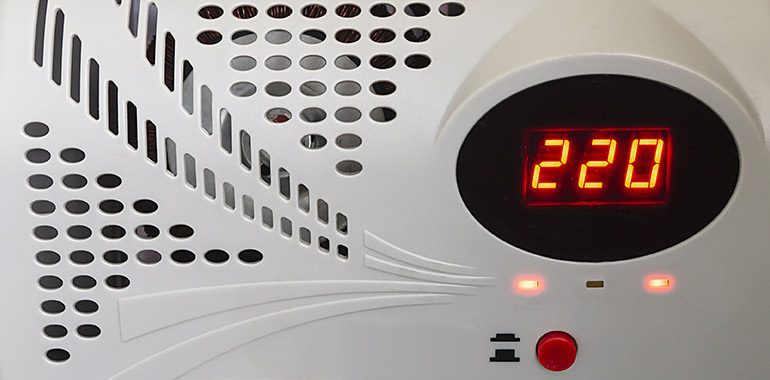We're In Your Neighborhood!

Same Day Service
Since 2001
Call The Gentleman Pros Now!
(403) 879-1759
We're In Your Neighborhood!


Same Day Service
Since 2001
Call The Gentleman Pros Now!
(403) 879-1759

Electricity is incredibly useful but every so often it tends to run amok in the form of power surges. Power surges can damage and even ruin your valuable appliances and electrical devices (e.g. laptops, home theatre equipment, and stereo systems). Their replacement cost can be steep. So, you should protect them by installing a whole-house surge protector.
“Stanley R. was my electrician today. He was excellent and on time. He wasProfessional but appropriately personable. He did the repair conscientiously and answered all my questions. He explained the possible upgrade without excessive upselling the repair. Good work Stanley R.” Howard P

A whole-house surge protector defends your electrical equipment and gadgets from voltage spikes regardless of where they come from. Electrical surges (also called voltage spikes, transient voltage, or power surges) can stem from outside your home (external power surge) or from inside your home (internal power surge).
They are an increase in voltage that lasts fractions of a second and varies in duration and intensity. The increased voltage can range from one or two volts above the voltage threshold to thousands of excess volts.
High-voltage power surges can cause instant damage to your devices. The increased voltage running through the device can melt parts, fry wiring, and even ruin the device.
Low-voltage electrical surges aren’t even noticeable. However, they can limit the lifespan of your devices by causing a tiny bit of damage every time a surge occurs. This damage causes deterioration of the devices’ circuity until it eventually stops working.
Power surges are common and can happen numerous times a day. Luckily the vast majority are low-level surges.
A whole-house surge suppressor is hardwired into your main breaker panel, protecting your electronics from internal and external power surges.
When this piece of equipment senses an increase in voltage over the safe threshold, it immediately diverts the excess voltage into your home’s grounding system.
Our knowledgeable electricians are experts in surge protectors. They will ensure you get a model compatible with your electrical panel, has the right voltage protection rating (clamping voltage) and joule rating to keep you protected, and fits within your budget.
Once you are happy with your selection, our skilled electricians will install it for you and clean up after themselves.
Let’s talk surge protectors. Give us a call at (403) 879-1759, fill out our convenient online form, or click on the Chat With Us icon on this page and one of our courteous customer service reps will gladly give you a hand.

Power surges are created when the electricity flow is stopped and then started again, or when a device sends electricity flowing back into the system.
It is an over-voltage condition. An over-voltage condition is when there is more voltage present than normally should be. It is an increase in voltage that exceeds the normal threshold.
In Canada, our residential electrical systems are 120 V systems. However, the voltage in our homes doesn’t stay at a steady 120 V. It can fluctuate between 0 volts and 169 volts.
When the voltage exceeds 169 volts it is considered a power surge. Surges can range from 1 volt over 169 volts to several thousand volts over and last microseconds. They vary in magnitude and duration.
Yes, there are several. They include electrical surge, voltage surge, and transient voltage.
There isn’t just one cause of power surges. There are a number of causes of power surges.
Your large appliances require a lot of energy to turn on and off their motors and compressors. These sudden demands for energy can disrupt the power flow to other devices on the circuit and cause a power surge.
Your refrigerator, air conditioning, and HVAC units are the ones usually responsible for these power surges. These are lower-intensity power surges which is a good thing because these types of surges occur several times a day.
An overload happens when too much electricity is being used on a single circuit. For example, when you plug too many things into one circuit. This extra demand for electrical current can cause a power surge. Circuit breakers protect your home from excess amperage (current) but cannot protect your home from excess voltage.
Hair dryers, power tools, space heaters, and large appliances are the main culprits in causing a power surge due to electrical overload.
Bad wiring in your home can also cause power surges. Faulty wiring doesn’t resist electricity between the hot, neutral, and ground wires to the same extent as good functioning wiring. The lower the resistance of your wiring, the higher the voltage.
This lack of resistance can cause a power surge.
Clues you have faulty wiring creating power surges include:
If you notice any of these clues, please unplug any connected devices, turn off the electricity to that circuit, and call an electrician.
Power outages happen when there has been a large-scale power grid failure. The power outage doesn’t cause the power surge. Rather it can occur when the power comes back on. A sudden jump in voltage can happen when power is restored after an outage.
This section should be called anything that can cause downed power lines and a power outage, even a small one that only affects a few households.
Fallen tree limbs and vehicle accidents are frequent causes of downed electrical lines and cause outages.
Critters, like snakes, birds, and squirrels can interfere with electrical grid equipment, causing power outages. Animals use the lines to travel (we see you squirrels) or sit on (we see you birds) and some get into transformers and substations. Often these interactions lead to power failure and unfortunately, the animals usually do not survive.
The outage does not cause a power surge. Just like the widespread power outage, power surges can be created when electricity is restored.
It’s probably the least common cause of a power surge. If lightning strikes near a power line regardless if it is underground, in a building, or outside, the electrical energy in the lines can be boosted by the electrical charge from the lightning. In fact, it can be boosted by millions of volts creating an extraordinarily large power surge.
Fortunately, power surges caused by lightning are extremely rare because few if any of the power surge protectors on the market could stop or suppress a power surge of this magnitude.
In a lightning storm, your best form of defense from a power surge is to unplug all your electronics, appliances, and gadgets.
Power surges are a common occurrence and can take place dozens of times a day. We don’t even notice the majority of them. We’re just happy that the big power surges of several thousand volts are few and far between.



